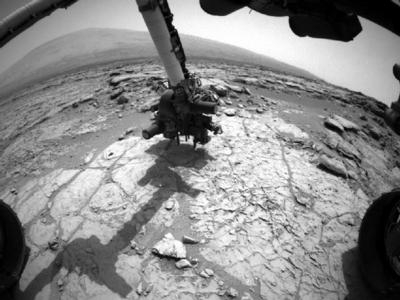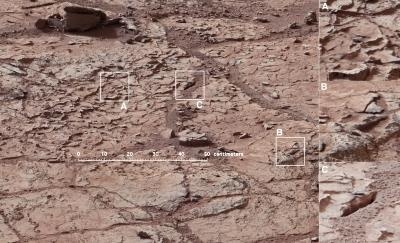Thu, Jan 31, 2013
'Pre-Load' Test Determines Force Needed To Penetrate The Martian Rock
NASA's Mars rover Curiosity has placed its drill onto a series of four locations on a Martian rock and pressed down on it with the rover's arm, in preparation for using the drill in coming days. The rover carried out this "pre-load" testing on Mars Monday (PST). The tests enable engineers to check whether the amount of force applied to the hardware matches predictions for what would result from the commanded motions.

The next step was an overnight pre-load test, to gain assurance that the large temperature change from day to night at the rover's location does not add excessively to stress on the arm while it is pressing on the drill. At Curiosity's work site in Gale Crater, air temperature plunges from about 32 degrees Fahrenheit (zero degrees Celsius) in the afternoon to minus 85 degrees Fahrenheit (minus 65 degrees Celsius) overnight. Over this temperature swing, this large rover's arm, chassis and mobility system grow and shrink by about a tenth of an inch (about 2.4 millimeters), a little more than the thickness of a U.S. quarter-dollar coin.
The rover team at NASA's Jet Propulsion Laboratory, Pasadena, CA, sent the rover commands yesterday to begin the overnight pre-load test today (Monday).
"We don't plan on leaving the drill in a rock overnight once we start drilling, but in case that happens, it is important to know what to expect in terms of stress on the hardware," said JPL's Daniel Limonadi, the lead systems engineer for Curiosity's surface sampling and science system. "This test is done at lower pre-load values than we plan to use during drilling, to let us learn about the temperature effects without putting the hardware at risk."
Remaining preparatory steps will take at least the rest of this week. Some of these steps are hardware checks. Others will evaluate characteristics of the rock material at the selected drilling site on a patch of flat, veined rock called "John Klein."

Limonadi said, "We are proceeding with caution in the approach to Curiosity's first drilling. This is challenging. It will be the first time any robot has drilled into a rock to collect a sample on Mars."
An activity called the "drill-on-rock checkout" will use the hammering action of Curiosity's drill briefly, without rotation of the drill bit, for assurance that the back-and-forth percussion mechanism and associated control system are properly tuned for hitting a rock.
A subsequent activity called "mini-drill" is designed to produce a small ring of tailings -- powder resulting from drilling -- on the surface of the rock while penetrating less than eight-tenths of an inch (2 centimeters). This activity will not go deep enough to push rock powder into the drill's sample-gathering chamber. Limonadi said, "The purpose is to see whether the tailings are behaving the way we expect. Do they look like dry powder? That's what we want to confirm."
The rover team's activities this week are affected by the difference between Mars time and Earth time. To compensate for this, the team develops commands based on rover activities from two sols earlier. So, for example, the mini-drill activity cannot occur sooner than two sols after the drill-on-rock checkout. Each Martian sol lasts about 40 minutes longer than a 24-hour Earth day. By mid-February, the afternoon at Gale Crater, when Curiosity transmits information about results from the sol, will again be falling early enough in the California day for the rover team to plan each sol based on the previous sol's results.
(Images provided by NASA)
More News
Aero Linx: International Flying Farmers IFF is a not-for-profit organization started in 1944 by farmers who were also private pilots. We have members all across the United States a>[...]
From 2017 (YouTube Version): Remembrances Of An Israeli Air Force Test Pilot Early in 2016, ANN contributor Maxine Scheer traveled to Israel, where she had the opportunity to sit d>[...]
"We renegotiated what our debt restructuring is on a lot of our debts, mostly with the family. Those debts are going to be converted into equity..." Source: Excerpts from a short v>[...]
Also: B-29 Superfortress Reunion, FAA Wants Controllers, Spirit Airlines Pulls Back, Gogo Galileo Van's Aircraft posted a short video recapping the goings-on around their reorganiz>[...]
Chart Supplement US A flight information publication designed for use with appropriate IFR or VFR charts which contains data on all airports, seaplane bases, and heliports open to >[...]
 ANN's Daily Aero-Linx (04.15.24)
ANN's Daily Aero-Linx (04.15.24) Classic Aero-TV: 'No Other Options' -- The Israeli Air Force's Danny Shapira
Classic Aero-TV: 'No Other Options' -- The Israeli Air Force's Danny Shapira Aero-News: Quote of the Day (04.15.24)
Aero-News: Quote of the Day (04.15.24) Airborne 04.16.24: RV Update, Affordable Flying Expo, Diamond Lil
Airborne 04.16.24: RV Update, Affordable Flying Expo, Diamond Lil ANN's Daily Aero-Term (04.16.24): Chart Supplement US
ANN's Daily Aero-Term (04.16.24): Chart Supplement US




